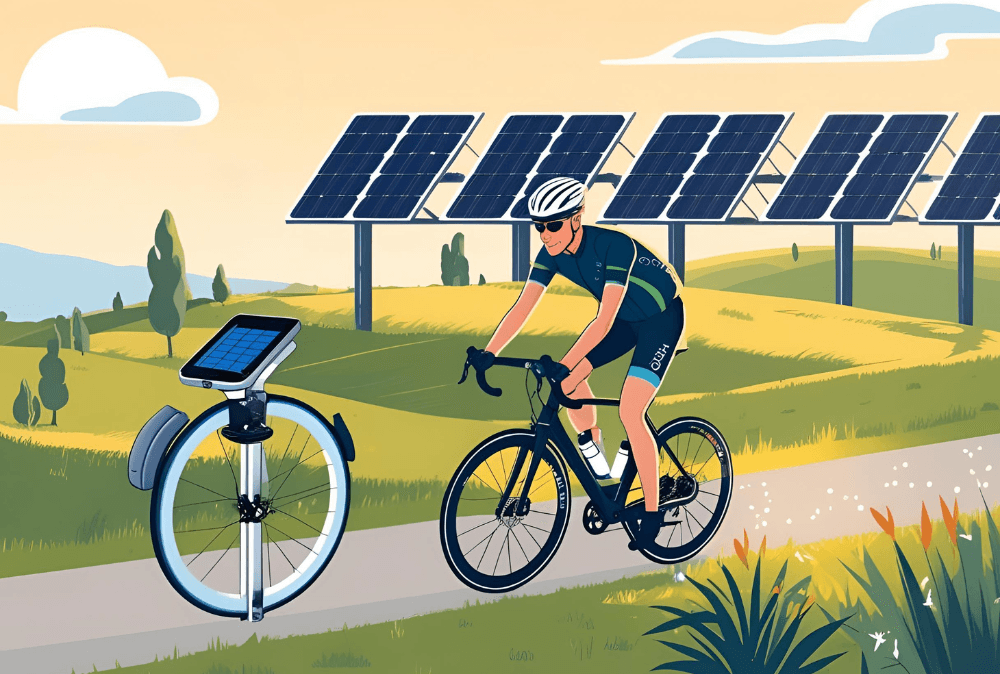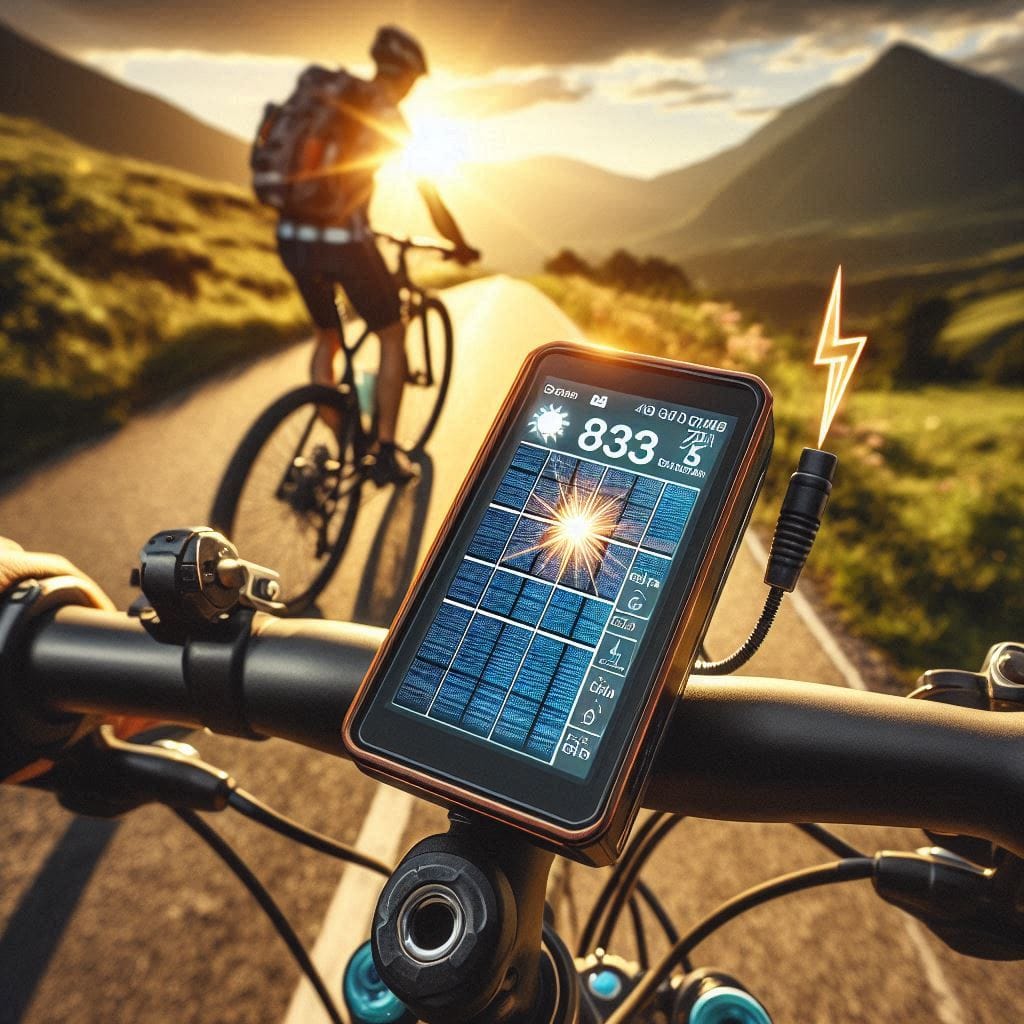Introduction
As cycling technology advances, solar bike computers are emerging as a key innovation for eco-conscious riders. These devices combine GPS solar cycling computer capabilities with solar-powered cycling technology, offering a best solar-powered bike computer solution that enhances both performance and sustainability. As the world moves towards greener transportation, these eco-friendly bike computers are gaining popularity for their ability to reduce battery waste and extend usability with solar charging.
Cyclists increasingly demand sustainable cycling technology that minimizes environmental impact while improving ride efficiency. Traditional bike computers rely on batteries that require frequent charging or replacements. In contrast, solar bike computers harness sunlight, reducing dependence on disposable batteries and ensuring extended ride times. With GPS navigation, real-time performance tracking, and seamless integration with cycling accessories, these devices are revolutionizing the biking experience.

What is a Solar Bike Computer?
Definition and Key Differences from Traditional Bike Computers
A solar bike computer is an advanced solar-powered cycling tech device that provides cyclists with real-time data on speed, distance, elevation, navigation, and performance metrics. Unlike traditional bike computers that rely solely on rechargeable or disposable batteries, solar-powered bike computers integrate solar panels to extend battery life, making them more sustainable and efficient.
Key Components of a Solar Bike Computer
- Solar Panels: Integrated into the device, these capture sunlight to recharge the battery and prolong runtime.
- GPS Tracking: A GPS solar cycling computer provides precise navigation, route planning, and tracking for professional and casual riders.
- Performance Sensors: Advanced models include heart rate monitors, power meters, cadence sensors, and barometric altimeters to optimize training.
- High-Resolution Displays: Sunlight-readable screens ensure visibility in bright conditions while reducing power consumption.
- Connectivity Features: Bluetooth, ANT+, and Wi-Fi allow integration with cycling apps, fitness trackers, and accessories for a connected ride.
Integration with Cycling Accessories and Apps
Most modern solar bike computers can sync with Strava, Garmin Connect, and Wahoo Fitness, providing data analytics and performance tracking. They can also pair with smartwatches, smart helmets, and even power meters to give cyclists deeper insights into their training and endurance levels. Garmin’s Edge 540 Solar and 840 Solar models, for example, offer predictive coaching, altitude acclimation tracking, and incident detection, enhancing safety and performance.
How Does a Solar Bike Computer Work?
A solar bike computer is an advanced cycling accessory that utilizes solar charging technology to extend battery life while providing real-time GPS tracking, performance analytics, and wireless connectivity. These devices enhance cycling experiences by minimizing power concerns and optimizing ride data collection.
Solar Charging Technology – Efficient Energy Harvesting While Riding
Modern solar-powered GPS cycling computers incorporate high-efficiency photovoltaic panels that convert sunlight into electrical energy. Devices like the Garmin Edge 1040 Solar integrate Power Glass™ solar charging technology, which adds up to 20-45 hours of extra battery life depending on sun exposure. This feature allows riders to harvest energy while cycling, reducing the need for frequent recharges and making the device ideal for endurance rides and long-distance touring.
Battery Backup and Hybrid Power Options
Solar bike computers don’t rely solely on solar power; they feature internal rechargeable batteries that store energy for use in low-light conditions. Some models offer hybrid charging, allowing cyclists to switch between solar and USB-C charging. The Garmin Edge 1040 Solar, for instance, can last up to 100 hours in power-saving mode, ensuring reliability even on extended rides without access to direct sunlight.
GPS Navigation, Real-Time Data Tracking, and Connectivity Features
These devices come equipped with multi-band GPS for accurate positioning, turn-by-turn navigation, and route rerouting in case of detours. Advanced models also integrate with Strava, Garmin Connect IQ, and third-party apps for post-ride analytics. Cyclists can monitor speed, cadence, heart rate, and power output while riding, with seamless data sync across mobile and web platforms.
Key Features and Benefits
Unlimited Power Supply with Solar Charging
The biggest advantage of a solar GPS bike computer is its ability to extend battery life indefinitely under optimal sunlight. Devices like the Garmin Edge 1040 Solar deliver continuous solar power boost, making them perfect for ultra-distance cyclists and adventure riders.
Real-Time GPS Tracking and Navigation
Solar-powered bike computers feature high-precision GPS with multi-band satellite support, ensuring accurate real-time location tracking, turn-by-turn navigation, and automatic rerouting. Whether you’re riding on highways, mountain trails, or remote areas, these computers provide reliable mapping and route planning.
Wireless Connectivity (Bluetooth, ANT+) for App Integration
Leading solar bike computers include Bluetooth, ANT+, and WiFi connectivity, allowing seamless integration with cycling apps, fitness trackers, and smart devices. Riders can pair their devices with heart rate monitors, power meters, and smartphones for a complete training ecosystem.

Advanced Performance Tracking (Speed, Distance, Heart Rate, etc.)
The best solar GPS bike computers feature detailed performance analytics, measuring:
- Speed and distance tracking via GPS
- Elevation and gradient detection for climbs and descents
- Heart rate monitoring when paired with compatible sensors
- Power output analysis for training optimization
These features help cyclists fine-tune their performance and endurance levels.
Weatherproof and Durable Design for Long Rides
Since cycling computers are exposed to harsh outdoor conditions, weatherproofing and durability are essential. High-end models are built with IPX7 water resistance, rugged casings, and anti-glare displays for clear visibility in bright sunlight.
A solar-powered GPS cycling computer offers unmatched convenience, long-lasting battery life, and advanced tracking capabilities, making it an ideal choice for endurance riders, commuters, and adventure cyclists. By combining solar charging efficiency, GPS navigation, and wireless connectivity, these devices eliminate power concerns while enhancing ride performance.
Solar Bike Computers vs. Traditional Bike Computers
With the rapid advancement of cycling technology, solar bike computers have emerged as a game-changer, offering a self-sustaining, eco-friendly alternative to traditional bike computers. While both types serve the core purpose of tracking ride data, navigating routes, and optimizing cycling performance, solar-powered models provide key advantages in sustainability, long-term cost-effectiveness, and energy independence. Below, we compare solar bike computers to standard models across key performance metrics.
Battery Dependency vs. Solar Self-Charging
Traditional bike computers typically rely on disposable batteries or rechargeable lithium-ion batteries, requiring frequent charging, especially for high-end GPS models. Riders who embark on long-distance tours or endurance cycling events often face challenges in keeping their devices powered.
Solar bike computers eliminate this issue by incorporating photovoltaic panels that continuously charge the internal battery while riding. Many models feature hybrid charging—a combination of solar power and USB charging—allowing users to extend battery life indefinitely under optimal sunlight conditions. Some of the best cycling GPS with solar power, such as the Garmin Edge 1040 Solar, claim to provide 50-100 hours of runtime, significantly reducing downtime due to charging.
Sustainability Benefits – Eco-Friendly and Energy-Efficient
As cyclists increasingly look for sustainable technology, solar-powered bike computers align with eco-friendly principles. By reducing reliance on disposable batteries and external power sources, solar bike computers contribute to lower electronic waste and reduced carbon footprint.
- Traditional bike computers, especially lower-end models, often rely on coin cell batteries (CR2032, etc.), which need replacement every few months and contribute to battery waste.
- Solar-powered cycling technology harnesses renewable energy, reducing reliance on electricity grids and disposable power sources.
For riders who prioritize green energy and sustainability, investing in a solar GPS bike computer is a step toward more environmentally conscious cycling.
Cost-Effectiveness in the Long Run
While the initial cost of a solar bike computer may be higher than a traditional bike computer, the long-term savings make up for it. Standard GPS bike computers require regular charging, and older models may need battery replacements or external power banks for extended rides. This adds both monetary and environmental costs over time.
A solar bike computer, on the other hand, reduces lifetime maintenance costs:
- No need for frequent battery replacements.
- Less reliance on portable power sources for long tours.
- Greater resale value, as solar charging is a desirable feature in premium models.
For serious cyclists and outdoor enthusiasts, the higher upfront investment in solar-powered cycling technology pays off in extended usability and reliability.
Comparison of Leading Solar Bike Computer Brands
Several leading brands have integrated solar technology into their GPS bike computers, setting a new standard for high-performance cycling devices. Below is a comparison of some of the best solar-powered bike computers vs. traditional models:
| Feature | Garmin Edge 1040 Solar (Solar) | Wahoo ELEMNT ROAM (Traditional) |
|---|---|---|
| Battery Life | Up to 100 hours with solar | 17 hours max |
| Solar Charging | Yes, Power Glass™ technology | No |
| GPS Navigation | Advanced multi-band GPS | Multi-band GPS |
| Connectivity | Bluetooth, ANT+, Wi-Fi | Bluetooth, ANT+, Wi-Fi |
| Durability | IPX7 waterproof, rugged | IPX7 waterproof |
| Sustainability | Uses renewable energy | Battery-dependent |
| Price | $749 | $399 |
- Garmin Edge 1040 Solar: One of the best solar-powered bike computers, featuring Power Glass™ solar technology that extends battery life significantly.
- Wahoo ELEMNT ROAM: A traditional premium bike computer with advanced mapping, but dependent on standard battery charging.
Final Verdict: Which One is Better?
For casual cyclists and budget-conscious riders, traditional bike computers may still be a viable choice. However, for endurance cyclists, adventure riders, and eco-conscious users, solar bike computers provide superior energy efficiency, longer usability, and a reduced environmental footprint.
With continuous improvements in solar panel efficiency and battery technology, the future of cycling is shifting toward self-sustaining, solar-powered cycling technology. Investing in the best solar bike computer today ensures greater performance, reduced charging hassle, and long-term cost savings.
Popular Solar Bike Computers in the Market
Review of Top Solar Bike Computers
The market for solar-powered bike computers has grown significantly in 2025, with brands like Garmin, Wahoo, Bryton, and Sigma leading the way. These advanced cycling gadgets now offer better GPS accuracy, long battery life, and smart connectivity features.
One of the most highly-rated solar bike computers is the Garmin Edge 1040 Solar, known for its:
- Solar charging technology, which extends battery life up to 100 hours in power-saving mode.
- Multi-band GNSS (Global Navigation Satellite System) for ultra-precise navigation.
- Advanced performance tracking and training metrics to enhance cycling efficiency.
Other notable models include:
- Wahoo ELEMNT ROAM – Features turn-by-turn navigation, live tracking, and a high-contrast color display but lacks solar charging.
- Bryton Rider S800 – A budget-friendly model with voice search, large screen navigation, and extended battery life (36+ hours).
- Sigma ROX 12.1 EVO – Offers detailed maps, structured workouts, and a touchscreen interface, making it a strong competitor.
Comparison of Features, Battery Life, and Accuracy
| Model | Best For | Battery Life | Unique Feature |
|---|---|---|---|
| Garmin Edge 1040 Solar | Long-distance rides | Up to 100 hrs (solar mode) | Solar charging + GNSS navigation |
| Bryton Rider S800 | Budget-conscious cyclists | 36+ hrs | Voice search + training features |
| Wahoo ELEMNT ROAM | Serious road cyclists | 17+ hrs | Easy-to-use mapping & training app integration |
| Sigma ROX 12.1 EVO | Commuters & workout tracking | Up to 16 hrs | Full touchscreen navigation |
Best Solar Bike Computers for Different Riding Styles
- Mountain Biking → Garmin Edge 1040 Solar (rugged design, best GPS accuracy).
- Road Cycling → Bryton Rider S800 (lightweight, advanced training tools).
- Commuting → Sigma ROX 12.1 EVO (easy-to-read display, quick route calculations).
If you’re looking for the best solar-powered bike computer in 2025, Garmin Edge 1040 Solar remains the top choice, thanks to its unmatched battery life, solar charging, and precise GPS tracking. However, depending on budget and specific cycling needs, Bryton, Wahoo, and Sigma also offer competitive options.
Sustainability and Environmental Impact
Reducing Battery Waste with Solar Technology
One of the biggest advantages of solar energy in biking is its ability to reduce battery waste. Traditional cycling computers rely on disposable or rechargeable lithium-ion batteries, which contribute to electronic waste. Solar-powered bike computers like the Garmin Edge 1040 Solar eliminate the need for frequent recharging, reducing dependence on disposable batteries.
Lowering Reliance on Disposable/Rechargeable Batteries
By integrating solar panels into bike computers, cyclists reduce the environmental footprint of their devices. This technology extends battery life significantly, meaning fewer discarded batteries ending up in landfills.
Encouraging Sustainable Commuting and Eco-Conscious Cycling
Solar-powered bike computers align with the eco-friendly cycling technology movement. By harnessing solar energy, cyclists can reduce their carbon footprint while enjoying longer battery life and better energy efficiency. This makes solar-powered cycling gadgets a step toward a greener future.
Future of Solar Bike Computers and Smart Cycling Tech
The future of solar-powered bike computers looks promising, with innovations in solar efficiency, AI-driven analytics, and self-sustaining smart bike ecosystems. As technology advances, these devices will become even more intelligent, efficient, and seamlessly integrated into modern cycling experiences.
Advancements in Solar Efficiency for Bike Computers
One of the biggest challenges for solar-powered bike computers has been optimizing energy conversion efficiency. Future models will likely feature:
- Next-gen photovoltaic cells: Companies are working on high-efficiency perovskite and multi-junction solar cells that can capture more sunlight, even in low-light conditions.
- Flexible and integrated solar panels: Future solar bike computers could integrate solar film directly onto handlebars or bike frames, ensuring continuous energy harvesting.
- Energy storage improvements: Solid-state batteries and supercapacitors will store excess solar energy more efficiently, reducing reliance on backup charging.
Integration with AI and Machine Learning for Smarter Cycling Insights
AI and machine learning are already transforming cycling performance tracking, and solar-powered bike computers will soon leverage these technologies for:
- Real-time ride optimization: AI-driven algorithms will analyze terrain, weather, and rider performance to suggest energy-saving routes and pacing strategies.
- Predictive maintenance: Smart bike computers will monitor gear wear, tire pressure, and battery life, alerting riders to necessary maintenance before failures occur.
- AI-powered coaching: Future solar GPS bike computers will provide personalized coaching based on biometric data, offering real-time feedback for cyclists.
Potential for Self-Sustaining Smart Bike Ecosystems
The future of solar-powered cycling tech extends beyond GPS computers. Emerging self-sustaining smart bike ecosystems could include:
- Solar-powered bike lights that automatically adjust brightness based on surroundings.
- Auto-adjusting electronic gears, powered by solar energy, to improve efficiency on different terrains.
- Wireless energy-sharing between bike components (e.g., charging bike lights, action cameras, and smart helmets from a single solar source).
- IoT-enabled solar bike computers that sync with smart city infrastructure, providing real-time cycling route updates, traffic alerts, and environmental monitoring.
With solar energy in biking advancing rapidly, the future of solar-powered bike computers is set to redefine smart cycling technology.
Conclusion
The emergence of solar bike computers marks a significant shift in cycling technology, offering a sustainable, efficient, and feature-rich alternative to traditional bike computers.
- Solar-powered GPS cycling computers provide unlimited power on long rides, reducing the need for frequent charging.
- Advances in solar panel efficiency, AI-driven performance tracking, and IoT integration will revolutionize how cyclists interact with their gadgets.
- The growing demand for eco-friendly cycling technology aligns with global sustainability efforts, making solar energy in biking a long-term trend.
Why Solar Technology is the Future of Smart Cycling Gadgets
As solar technology improves, the best solar-powered bike computers will become more efficient, durable, and seamlessly integrated into cycling ecosystems. Solar charging, once a novelty, is now a game-changer, extending battery life and enhancing performance tracking without increasing environmental impact.
Call to Action: Best Models for Eco-Friendly Cycling
For cyclists looking to invest in sustainable, high-tech bike computers, here are the top recommendations:
- Best Overall: Garmin Edge 1040 Solar (long battery life, accurate GPS, and solar efficiency).
- Best for Budget-Friendly Performance: Bryton Rider S800 (affordable and feature-rich).
- Best for Commuting: Sigma ROX 12.1 EVO (fast route calculations and easy navigation).
The future of cycling is solar-powered. Upgrading to a solar GPS bike computer means enjoying cutting-edge features while reducing environmental impact. Whether you’re a road cyclist, commuter, or mountain biker, investing in solar-powered bike tech is a step toward a smarter, greener, and more connected ride. 🚴♂️🔆
Further Reading
AI is transforming modern astronomy, making celestial exploration more precise and accessible than ever before. If you’re interested in more groundbreaking innovations, be sure to check out our related blogs:
🔹 The Fascinating Invention of Bicycle – Discover how one of the greatest inventions in history revolutionized transportation.
🔹 Octillion Power Systems & Tata Battery: Future of EV Energy – Learn how these industry leaders are shaping the future of electric vehicle battery technology.
🔹 AuREUS Solar Panels – Explore how this next-gen solar technology harnesses ambient light to generate clean energy.
🔹 SolarWindow – A deep dive into transparent solar panels that are redefining sustainable energy solutions.
Stay tuned for more insights into cutting-edge technologies that are shaping the future! 🚀🔭






